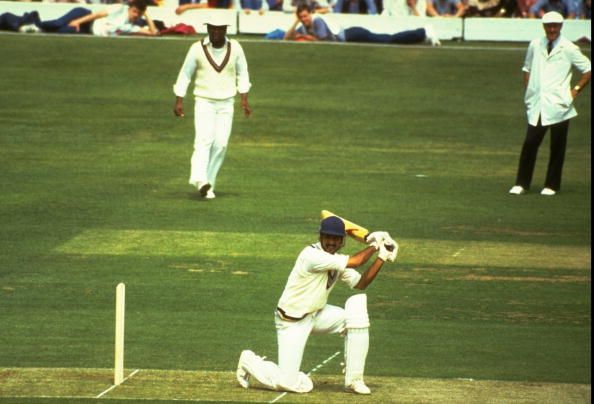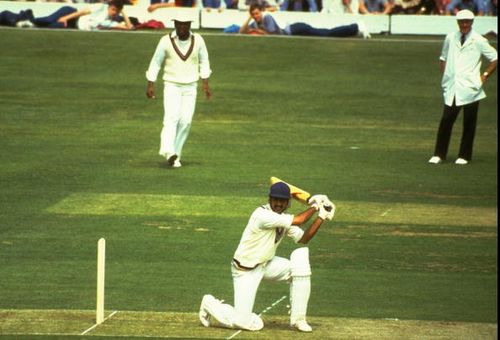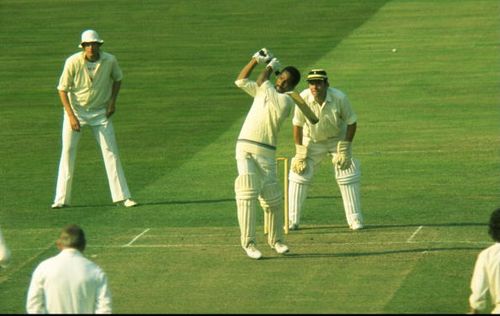
The bygone era’s best T20 XI
The IPL is in full swing, making the hearts of cricket lovers go racing with its thrilling cricket and close finishes. T20 cricket is a different form and requires a particular set of skills that not every cricketer can be good at. And that is why we see the Dhonis, the Gayles and the Steyns doing particularly well in this format with their exorbitant T20 skills.
As I see these players exceeding so well in this format, I wonder what it must have been like if some cricketers from the bygone era would have played this game. The thought becomes more evident when one sees the likes of Ricky Ponting and Sachin Tendulkar, Chris Gayle and AB De Villiers playing together for the same team, thus making me wonder how it must have been like to see the legends of the bygone era in the same team playing together.
When we think of cricket in the ’70s and the 80s we generally think of long and boring days of cricket in whites. Even the ODIs of that era are not something we associate with anything remote to thrilling cricket. But as I search the annals of cricket history, I find that there are quite a few players who would have surely excelled equally well in the shortest format of the game today. Hence, I try and conjure a fantasy eleven from those many exquisite cricketers of that era and blend them in one team, thinking what a sight it would have been to see these greats playing T20 cricket together for one squad.
My selections are obviously open to debate and will perhaps be also criticized by many. But please do understand that it was an excruciatingly difficult task to pick out these eleven greats from a plethora of so many. I picked them all without any bias and with the hope that they actually make you visualize the sheer beauty of this delicious impossibility.

1. Krishnamachari Srikkanth (India)
T20 cricket was perhaps tailor-made for this guy. It is just unfortunate that Krishnamachari Srikkanth took birth in an earlier era. His entertaining, innovative and explosive style of batting would have surely been a sure bet to succeed in T20 cricket and he undoubtedly would have been the crowd favourite as well. The swashbuckling opening batsmen could destroy any bowling attack on his day with his uninhibited driving, pulling and hooking. Though not known to be consistent in his playing days, Srikkanth would surely have had more chances to succeed in this format consistently, given the quick reflexes and good eye that he possessed. With good fielding skills to go with it, he would have been a certainty in the opening slot.
2. Gordon Greenidge (West Indies)
A more than ideal partner to the quirky Srikkanth would have been this massively destructive opening batsman of the West Indies. Greenidge had a very sound technique, and could attack and defend with equal aplomb. However, it was attacking that seemed to be in his genes, thus making him an attractive option at opening slot in T20 cricket. His square-cuts, pulls and hooks were brutal and would make any bowler bowling to him in the powerplay overs sweat today. However, it was not just all attack for Greenidge, and he could build an innings adequately as well when required. With his murderous off and on drives, he would have killed the bowlers in the death overs.
3. Dean Jones (Australia)
A master-class in the art of batting in one-day cricket, Dean Jones would have walked into any T20 squad with ease today. Lest the openers fall early, Jones would have been an ideal candidate to bring normalcy to the proceedings at the very important number 3 slot with his composed demeanour. A panther when running between the wickets, Jones could slowly build an innings with his quick singles and occasional fours. And before the opposition would realize it, he would have already bailed his team out and stood on a neat score. He was an outstanding fielder as well, a necessary trait in T20 cricket, and thus would have been one of the most vital members of the squad.
4. Sir Vivian Richards (West Indies)
Murder, destruction, mayhem. These are some of the words that you can associate with this legendary batting star from the Caribbean islands. Whilst at the crease, Richards was a dread to any bowler, purely because of the ruthless and undaunted way he could plummet, intimidate and murder any bowling attack into submission. The record holder of the fastest century in Test cricket history, Richards would have possibly made T20 cricket his own. What with his swagger, ‘no-helmet wearing’ and gum-chewing dynamics, the West Indian would probably have been the best advertisement T20 cricket requires today. It would have been very difficult for any bowler to set the right line and length for him and at number 4 in the batting order, the opposition would surely have done with some prayers to save them from his wrath.
5. Javed Miandad (Pakistan)
One of the greatest batsmen that Pakistan has ever produced, Miandad would have excelled in T20 cricket as well because of his sheer versatility as a cricketer. An almost perfect man to come at number 5 if the team has a mini batting collapse, Miandad, with his aggressive running, fine shot placements and working the ball in gaps for runs, would have soothed the nerves of the dugout with his calm presence at the crease. When the need arrived, he knew how to attack as well, with his fierce square cuts, drills over mid-wicket and other innovative shots, like the reverse-sweep, of which he was one of the early inventors. We know he could handle pressure well if the game went down to the wire, as he displayed with his famous last ball six of Indian pacer Chetan Sharma in 1986 to win the Australasia Cup for Pakistan. Hence, Miandad, at the number 5 position, would have fit the bill perfectly.

6. Sir Garfield Sobers (West Indies)
Arguably the greatest all-rounders the game of cricket has ever seen, this legendary West Indian would have been an automatic first-choice for any T20 team. Having been the first player to have hit six sixes in an over in a first-class game, not much needs to be added about his destructive abilities as a batsman. At number six, he would mostly be coming with about 5-6 overs remaining and his elegant and destructive batting would have taken his team through to massive totals. And if the required run-rate would be too daunting, the captain could even send him at number three sometimes, to take the attack to the opposition. His bowling too was an asset, and he could walk into any team purely on his bowling skills alone. He bowled two styles of spin – left-arm orthodox and wrist spin, and was also a fine fast-medium opening bowler. Added to this was the fact that that he was an electric fielder, thus making Sobers the most precious T20 cricketer in the team hands-down.
7. Kapil Dev (India) – [Captain]
One of the greatest pace bowlers and all-rounders that India has produced, Kapil Dev would have undoubtedly made an excellent T20 cricketer. With his outstandingly tight line and length, and the ability to swing the ball late and away from the batsmen, he would have been very difficult to get away, even in the powerplay overs. His batting, too, was uncomplicated and he could strike the ball a fair bit, making him a necessity in a T20 squad. Perhaps he could have used himself as a pinch-hitter sometimes, coming up the order when the required rate at the start of the innings would be above 10. The World Cup winning captain would also be the best man to lead this star team with his excellent leadership abilities.
8. Sir Richard Hadlee (New Zealand)
Quite in the similar mould as Kapil Dev and perhaps even better, Hadlee would be the perfect choice for the third man in the all-rounder slot. The first man to reach 400 wickets in Tests, the Kiwi would have made a lethal opening bowler, what with his sharp pace, bounce and movement from even on the least responsive of surfaces. Added to this was his ability as a hard-hitting batsman lower down the order, which, in the case of batting collapses or tricky situations, would have come more than handy, thus making him an asset to any T20 team.
9. Rodney Marsh (Australia) – [Wicket-keeper]
One of the finest wicket-keepers to have played the game, Rodney Marsh would have been the ideal man to don the wicket-keeping gloves to face the great bowlers in this team. With 355 dismissals under his belt, Marsh was nimble-footed and had great anticipation and reflexes behind the stumps despite being robustly built. A colourful character, Marsh was also more than handy with the bat, attacking and defending with equal aplomb, and his potent stroke play would have been handy to the team in times of need.
It was difficult letting go of the other possible entry in this slot, England’s Alan Knott. But Marsh had the experience of playing 90 ODIs as compared to Knott’s 20, and thus would walk in ahead of him in a T20 squad.
10. Dennis Lillee (Australia)
The Australian was known as the most ‘complete fast bowler’ of all time. Bowling at frightening pace, Lillee would have been the obvious choice of an opening fast bowler in a T20 game. His sheer pace, ruthless aggression and relentless stamina would surely have got the crowd going. Any batsman would have feared facing him as he knew how to sort batsmen out with his clever variations in length, pace and movement. The fact that he would have had only four overs to bowl in a T20 game makes him doubly dangerous, as he would have bowled his heart out. Lille, undoubtedly, would have been the ‘go-to man’ for the captain in difficult situations, who could have used him in short one over bursts throughout the innings.
11. Abdul Qadir (Pakistan)
A T20 team cannot be complete without the services of a genuine spinner and this wily leg-spinner from Pakistan would have fit the bill perfectly. Known for his variations, Qadir could bowl six different deliveries in an over. He had two different googlies, a lethal spinner and hard to gauge leg-breaks to bamboozle the batsmen. He would have probably come in to bowl in the middle overs, making it difficult for the batsmen to get him away with his guile and turn. Not one to wilt easily in pressure situations, Qadir would have held his own when batsmen went after him. He was also no mug with the bat and could attack occasionally, making him an almost perfect selection in the squad.